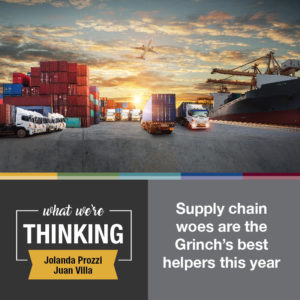 By Jolanda Prozzi and Juan Villa
By Jolanda Prozzi and Juan Villa
If this year’s holiday shopping season has you feeling a bit more anxious than most in recent memory, you may find consolation in knowing that your angst is likely not a product of your imagination.
You can blame the same supply chain woes that have plagued us since the pandemic-driven panic-buying days of spring 2020. Never before has getting our stuff from point A to point B been more challenging, as we explained in a recent podcast. And though the challenges are complicated, the causes primarily boil down to a few simple realities.
One – Supply chains have become increasingly lean. Manufacturers and retailers for years have been trying to squeeze efficiencies out of those chains to be more competitive. The good news is that those efficiencies can hold prices down for consumers. The bad news is that the squeeze can make the chains more vulnerable to disruptions, particularly with the more fragile links.
Two – Supply chains have become more global. Product components are sourced from multiple countries based on which country can produce parts at the lowest cost. When a single component doesn’t make it to the manufacturer, the entire process can break down. We saw this in 2011, for instance, when the earthquake and tsunami that struck Japan caused the temporary closing of a General Motors truck plant in Louisiana because of a lack of Japanese-made truck parts.
Three – An already-strained global infrastructure cannot nimbly respond to sharp fluctuations in consumer demand. When cargo ships that long sat empty and idle are suddenly filled and oceangoing, they must wait offshore at gridlocked U.S. seaports – often for weeks or months – before unloading. Even then, a product’s journey to market may be further stalled by a long-standing nationwide shortage of truck drivers and warehouse workers.
The port and roadway system is like a funnel. Cargo, whether on ships, rail cars or 18-wheelers, can only flow along at a certain pace. There are no detours, no alternative funnels, because virtually all shippers and distributors use the same infrastructure. You can choose which service you prefer for home deliveries, but you have no choice when it comes to which ports and roadways are used to enable those deliveries.
The nation’s biggest retailers can sidestep some of these problems, but smaller companies or retailers routinely don’t have the leverage, so their specialty items may be harder to come by.
For holiday shoppers, all of this can add up to fewer choices and longer waits. Efficiency measures over the years have held down costs to consumers, but they’ve also eroded redundancy in the supply chains, making them more vulnerable to disruptions. It’s a rather simple trade-off. We can have lower prices, or greater reliability in product availability, but we cannot have both at the same time.
What we’re experiencing now has been years in the making. Whether a storm was coming was not in question; the only uncertainty was when it would hit. Now we know.
Supply chains are a bit like the utility services we have in our homes. We don’t think about them all that much, until something goes wrong. Whether it’s tap water or toilet paper, when the availability is suddenly shut off, we know we’re in trouble. What we don’t know, typically, is how long that trouble is going to last.
One thing is certain. Without meaningful solutions along every step – addressing every link in the chain – there’s a strong chance that the next holiday shopping season won’t be any easier than the one now upon us.
Jolanda Prozzi is a senior research scientist at the Texas A&M Transportation Institute. Juan Villa is a research scientist at the institute.
This article was originally published in the The Dallas Morning News, December 19, 2021.